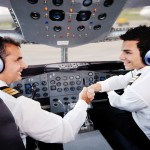Keys to effective swift-starting teams
 Next time you’re standing at the gate waiting to get on a flight and the crew shows up, watch how they interact with each other. It will tell you a lot about how effective as a team they are going to be up in the sky shortly.
Next time you’re standing at the gate waiting to get on a flight and the crew shows up, watch how they interact with each other. It will tell you a lot about how effective as a team they are going to be up in the sky shortly.
Mary Waller, a researcher at York University in Toronto, has been studying swift-starting teams – and flight crews in particular. Swift-starting teams of experts are everywhere – TV news crews comprised of journalists, camera, lighting, audio, and transmission engineers who come together to cover a media event. The doctors, nurses, technicians in hospitals who assemble for a ER shift to work together. Or the engineers that may run a nuclear power plant. In many cases these teams are comprised of highly-specialized professionals who assemble as a team for a specific job or task, and sometimes have little or no prior interaction with each other.
Specifically members of swift-forming experts teams are:
- competent and familiar with their complex work environments
- working quickly under situations of very evident time pressure
- have a stable role on the team but ad hoc team membership
- have complex, interdependent tasks that rely on interactions with team mates during the performance to yield coordinated execution of well-trained skills.
It turns out that how they interact with one another during just the first 15-20 minutes is highly predictive of how they will perform as a team for the duration of the job. The reason is that interaction patterns are established early in these relationships, and those patterns usually persist throughout the job.
Key #1: simple and consistent communication
Waller and her colleagues tracked each piece of dialogue uttered and identified the patterns in which they develop. For example, “Input the coordinates” is a command. “We have good weather today” is an observation. “Maybe we should ask tower control” is a suggestion and “What should our heading be?” is an inquiry…and so on to include disagreement, humor, anger or small-talk, etc. What they discovered is that patterns of interaction often emerge quickly and persist throughout the relationship. And the highest-performing teams established those patterns early, keep them simple, consistent, and reciprocal and balanced with one another. The lowest-performing teams had greater variety of conversational patterns, more unique communication patterns, and members who showed lack of reliance on other team members.
Key #2: short and targeted communication
While big locker room pep-talks or command-center speeches look good on television (think Ed Harris playing flight director Gene Kranz in Apollo 13), they aren’t terribly effective in driving team excellence. The most effective teams kept their communication short, precise and targeted to a specific task or job sequence.
Key #3: balanced communication
In the study, the researchers measured what they called “reciprocity.” That is, to what extent the team members relied on each other and balanced the participation of communication, as well as the reliance on one another for information and expertise. For example, if a team member showed “mono-actor” behavior of asking and answering their own questions, they showed less reliance, and less reciprocity on other team members. As a result, their study showed an overall decreased team performance when team members showed a lack of reliance on others and lack of reciprocity of expertise.
Here’s an interesting twist in the study. The researchers hypothesized that any “mono-acting” behavior (when someone asks and answers their own questions) would be on that part of the pilot currently in control. They thought that the person with command of the airplane would be the one offering the least reciprocity. Nope, it was the PNF (pilot not flying), who lacked control of the plane who exhibited the greatest amount of mono-acting behavior – in other words, was the least team player.
The best swift-forming teams of experts keep their communication simple, targeted and balanced.



